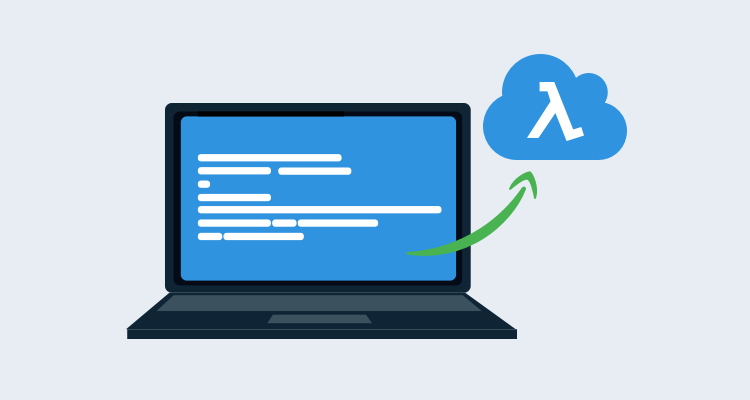As development patterns like microservices become increasingly popular, cloud providers are investing heavily in serverless computing platforms as a way of managing and executing many small and independent applications.
The AWS Serverless Application Model (AWS SAM) ties together the AWS services commonly used when deploying serverless applications. AWS SAM builds on CloudFormation and removes much of the common boilerplate code, making serverless application deployments quick and easy.
In this blog post, we’ll look at how you can move from the simple deployment processes provided by AWS SAM to repeatable deployments across multiple environments in Octopus.
The source code for this blog post is here.
The Hello World app
We’ll start with the Python Hello World application created with the SAM CLI tool. The process of creating this application is documented here.
The sample code that is generated by the SAM CLI commands sam init --runtime python3.7 and sam build has been committed to a GitHub repo, and we’ll use this repo as the starting point for our deployment process.
Building the application with Github Actions
If you follow the typical AWS SAM workflow, after running sam init and sam build, you’ll run a command like sam package --s3-bucket <your-bucket>, which will:
- Bundle up your source code with any dependencies.
- Upload the bundle to S3.
- Replace the
CoreUrifield in the SAM template with the location of the file in S3.
It’s important to note that CloudFormation, and therefore SAM, does not deploy code from your local PC; everything has to be uploaded to S3. The benefit of the sam package command is that it automates the work for you, resulting in a processed template that you can then deploy with CloudFormation.
However, the sam package command can be a little clunky when you need to implement repeatable deployments across multiple environments. The S3 file that is uploaded has a randomly generated name like fecddec7c6c40bd9de28f1775cd11e0e, which makes it nearly impossible to work out which code bundle was deployed for a given version. You’re also responsible for keeping a copy of the processed template file (i.e., the one with the updated CoreUri field) so that you can track which template was associated with what code.
Or to quote the SAM developers themselves:
Yes, “sam package” is rudimentary. Real solution is to create a better package command that will do content addressing better (may be using git sha, or content sha, or customer-provided naming function).
We’ll take a slightly different approach by managing packaging and uploading the package, and creating a generic template file that can be updated by Octopus during deployment. This will provide us with sane filenames and create reusable templates.
We’ll implement this with GitHub Actions with the following workflow YAML:
name: Python package
on: [push]
jobs:
build:
runs-on: ubuntu-latest
steps:
- uses: actions/checkout@v1
- name: Get Git Version
uses: docker://mcasperson/gitversion:5.0.2-linux-centos-7-netcoreapp2.2
with:
args: /github/workspace /nofetch /exec /bin/sh /execargs "-c \"echo $GitVersion_FullSemVer > /github/workspace/version.txt\""
- name: Set up Python 3.7
uses: actions/setup-python@v1
with:
python-version: 3.7
- name: Package dependencies
# Permissions are documented at
# https://docs.aws.amazon.com/lambda/latest/dg/deployment-package-v2.html
run: |
python -m pip install --upgrade pip
cd hello_world
pip download -r requirements.txt
unzip \*.whl
rm *.whl
chmod 644 $(find . -type f)
chmod 755 $(find . -type d)
- name: Extract Octopus Tools
run: |
mkdir /opt/octo
cd /opt/octo
wget -O /opt/octo/octopus.zip https://download.octopusdeploy.com/octopus-tools/6.12.0/OctopusTools.6.12.0.portable.zip
unzip /opt/octo/octopus.zip
chmod +x /opt/octo/Octo
- name: Pack Application
run: |
cd /home/runner/work/AWSSamExample/AWSSamExample/hello_world
zip -r /home/runner/work/AWSSamExample/AWSSamExample/AwsSamLambda.$(cat /home/runner/work/AWSSamExample/AWSSamExample/version.txt).zip *
- name: Push to Octopus
run: >-
/opt/octo/Octo push
--server ${{ secrets.MATT_URL }}
--apiKey ${{ secrets.MATT_API_KEY }}
--package /home/runner/work/AWSSamExample/AWSSamExample/AwsSamLambda.$(cat /home/runner/work/AWSSamExample/AWSSamExample/version.txt).zip
--overwrite-mode IgnoreIfExists
--space Lambda
- name: Pack Templates
run: >-
/opt/octo/Octo pack
--outFolder /home/runner/work/AWSSamExample/AWSSamExample
--basePath /home/runner/work/AWSSamExample/AWSSamExample
--id AwsSamLambdaTemplates
--version $(cat /home/runner/work/AWSSamExample/AWSSamExample/version.txt)
--include s3bucket.yaml
--include template.yaml
--format zip
- name: Push to Octopus
run: >-
/opt/octo/Octo push
--server ${{ secrets.MATT_URL }}
--apiKey ${{ secrets.MATT_API_KEY }}
--package /home/runner/work/AWSSamExample/AWSSamExample/AwsSamLambdaTemplates.$(cat /home/runner/work/AWSSamExample/AWSSamExample/version.txt).zip
--overwrite-mode IgnoreIfExists
--space LambdaThere are two parts to this workflow that allow us to replicate the functionality provided by the sam package command.
The first part is downloading the Python dependencies, extracting them, and setting the permissions on the files. We achieve this with the pip command to download the dependencies and extract the downloaded wheel files (or whl files, which are ZIP files with a different extension), which contain the dependency code:
- name: Package dependencies
# Permissions are documented at
# https://docs.aws.amazon.com/lambda/latest/dg/deployment-package-v2.html
run: |
python -m pip install --upgrade pip
cd hello_world
pip download -r requirements.txt
unzip \*.whl
rm *.whl
chmod 644 $(find . -type f)
chmod 755 $(find . -type d)The second part is where we create the zip file with a meaningful version number. If you look back at the workflow YAML, you’ll see we’ve generated this version number using GitVersion. The blog post Adding Versions to your GitHub Actions goes into more detail about how this versioning works.
We use the zip tool to package the Python code instead of the octo cli because AWS is very particular about the permissions of files inside the zip file. The zip tool creates the correct permissions, whereas the octo pack command would result in a ZIP file that could not be deployed.
- name: Pack Application
run: |
cd /home/runner/work/AWSSamExample/AWSSamExample/hello_world
zip -r /home/runner/work/AWSSamExample/AWSSamExample/AwsSamLambda.$(cat /home/runner/work/AWSSamExample/AWSSamExample/version.txt).zip *We create a second package to hold the templates. We have two templates here (s3bucket.yaml and template.yaml). These templates will be covered in more detail later on:
- name: Pack Templates
run: >-
/opt/octo/Octo pack
--outFolder /home/runner/work/AWSSamExample/AWSSamExample
--basePath /home/runner/work/AWSSamExample/AWSSamExample
--id AwsSamLambdaTemplates
--version $(cat /home/runner/work/AWSSamExample/AWSSamExample/version.txt)
--include s3bucket.yaml
--include template.yaml
--format zipThese packages are then pushed to the Octopus server with jobs calling octo push.
At this point, we have the application code and the templates uploaded to the Octopus server, ready to be deployed. We have replicated the bundling functionality of the sam package command, and the next step is to replicate the push to S3.
Uploading the package with Octopus
Before we push to S3, we’ll create the S3 bucket. This will be achieved with a standard CloudFormation template. In this template, we will specify that files in this S3 bucket are removed after a certain amount of time.
Normally, the sam package command pushes a file to S3 and leaves it there for eternity. However, once the file has been used to complete the deployment, it is no longer required, and since these files cost us money, it makes sense to clean them up after a period of time.
If we ever need to redeploy a version of an application, Octopus will re-upload the file:
AWSTemplateFormatVersion: 2010-09-09
Description: Creates an S3 bucket that cleans up old files
Resources:
CodeBucket:
Type: AWS::S3::Bucket
Properties:
BucketName: "#{S3BucketName}"
AccessControl: Private
VersioningConfiguration:
Status: Enabled
LifecycleConfiguration:
Rules:
- NoncurrentVersionExpirationInDays: 3
ExpirationInDays: 5
Status: EnabledNote the BucketName property has been defined as an Octopus variable. The marker #{S3BucketName} will be replaced with the value of the S3BucketName Octopus variable during deployment.
This template is deployed with the Deploy an AWS CloudFormation template step.
The CloudFormation settings define the region and stack name as variables. This will be important as we move to deployments across multiple environments:
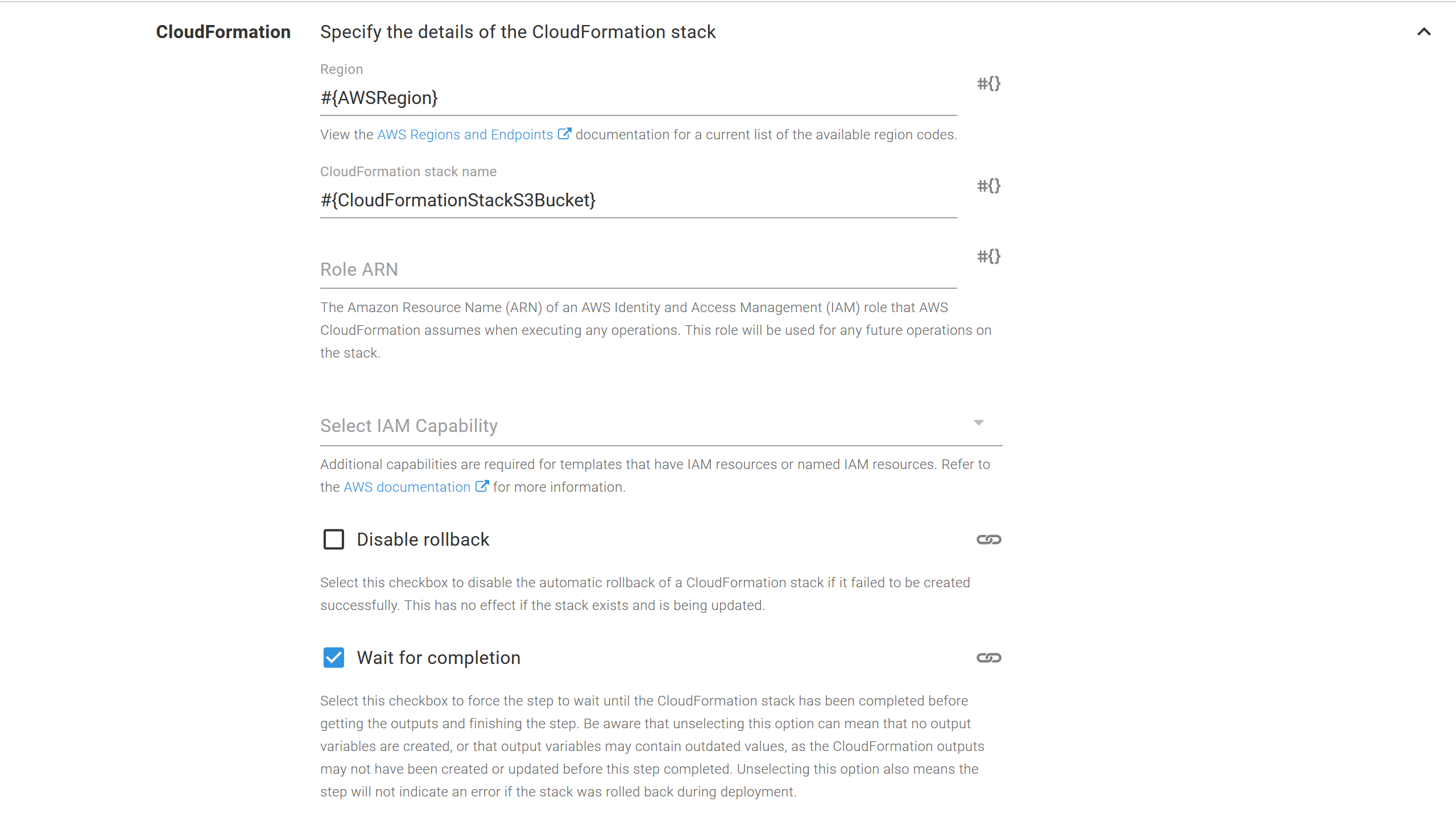
The CloudFormation template is then sourced from the package called AwsSamLambdaTemplates which has the file called s3bucket.yaml:

With the bucket created, the application package is then uploaded with the Upload a package to an AWS S3 bucket step.
The only thing of note in this step is that we have again used a variable for the bucket name and AWS region:
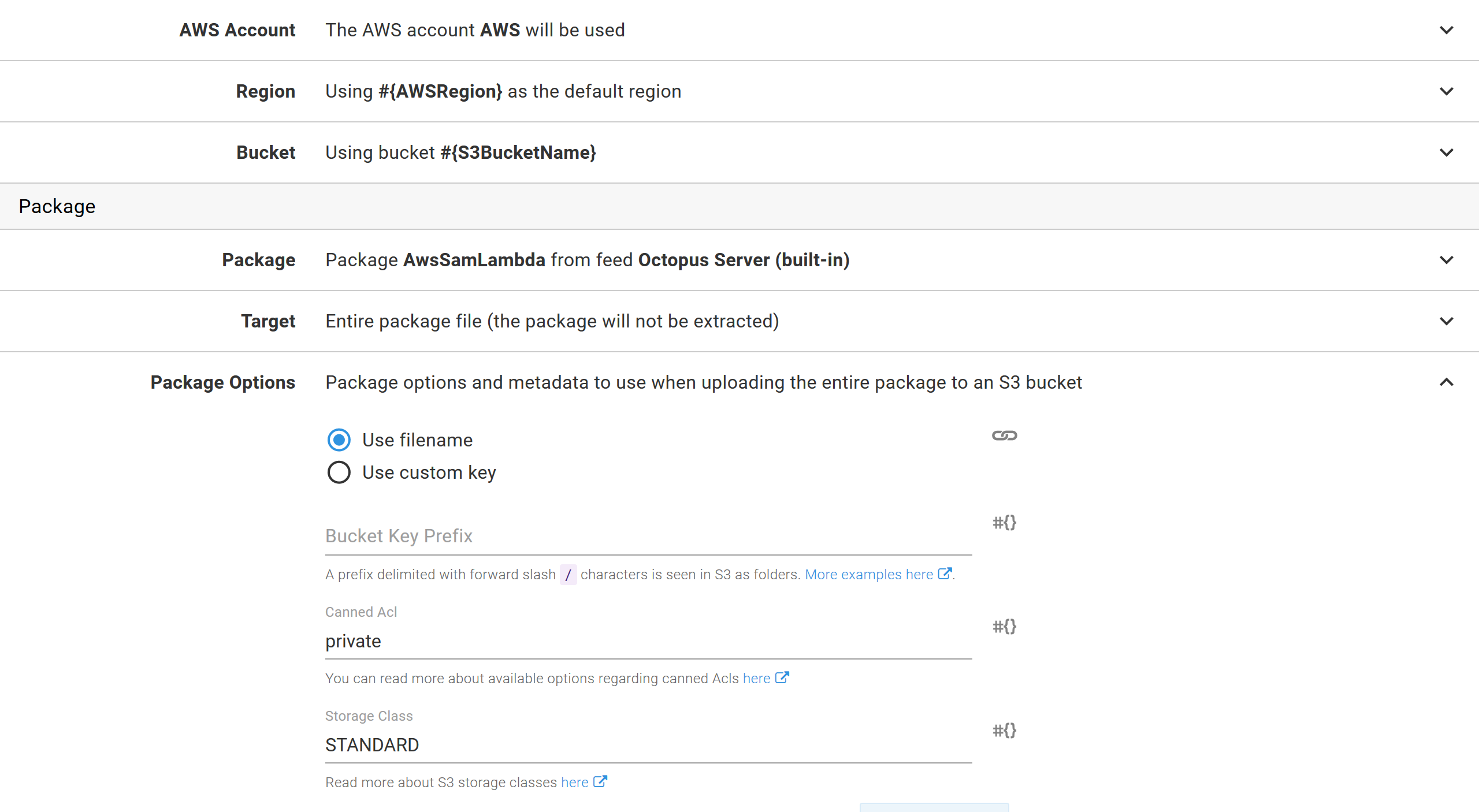
At this point, we have now replicated the functionality of the sam package command by bundling a self-contained application package using GitHub Actions and pushing it to S3 using Octopus.
We have also ensured that the packages we upload have readable names like AwsSamLambda.0.1.0+71.zip, which clearly indicate the application and version they contain. As you can see from the screenshot below, the packages uploaded by us (AwsSamLambda.0.1.0+xx.zip) offer a lot more context than the packages uploaded by sam package (fecddec7c6c40bd9de28f1775cd11e0e):

Deploying the template with Octopus
The final step is to deploy the SAM template as a CloudFormation template.
This template is almost a carbon copy of the one generated by the command sam init --runtime python3.7.
The first difference is that we set the OpenApiVersion value to 2.0. This fixes an issue where SAM creates a second, unwanted, API Gateway stage called Staging.
The second difference is that we have set the CodeUri property to "s3://#{Octopus.Action[Upload Lambda to S3].Aws.S3.BucketName}/#{Octopus.Action[Upload Lambda to S3].Output.Package.FileName}". These variable replacements combine to give us the name of the file that was uploaded to S3 in the previous Upload Lambda to S3 step.
AWSTemplateFormatVersion: '2010-09-09'
Transform: AWS::Serverless-2016-10-31
Description: Example SAM application
# More info about Globals: https://github.com/awslabs/serverless-application-model/blob/master/docs/globals.rst
Globals:
Api:
OpenApiVersion: '2.0'
Function:
Timeout: 3
Resources:
HelloWorldFunction:
Type: AWS::Serverless::Function # More info about Function Resource: https://github.com/awslabs/serverless-application-model/blob/master/versions/2016-10-31.md#awsserverlessfunction
Properties:
CodeUri: "s3://#{Octopus.Action[Upload Lambda to S3].Aws.S3.BucketName}/#{Octopus.Action[Upload Lambda to S3].Output.Package.FileName}"
Handler: app.lambda_handler
Runtime: python3.7
Events:
HelloWorld:
Type: Api # More info about API Event Source: https://github.com/awslabs/serverless-application-model/blob/master/versions/2016-10-31.md#api
Properties:
Path: /hello
Method: get
Outputs:
# ServerlessRestApi is an implicit API created out of Events key under Serverless::Function
# Find out more about other implicit resources you can reference within SAM
# https://github.com/awslabs/serverless-application-model/blob/master/docs/internals/generated_resources.rst#api
HelloWorldApi:
Description: "API Gateway endpoint URL for Prod stage for Hello World function"
Value: !Sub "https://${ServerlessRestApi}.execute-api.${AWS::Region}.amazonaws.com/Prod/hello/"
HelloWorldFunction:
Description: "Hello World Lambda Function ARN"
Value: !GetAtt HelloWorldFunction.Arn
HelloWorldFunctionIamRole:
Description: "Implicit IAM Role created for Hello World function"
Value: !GetAtt HelloWorldFunctionRole.Arn
As before, this template is deployed with the Deploy an AWS CloudFormation template step. However, we need to enable the additional capabilities of CAPABILITY_IAM because this template creates IAM resources, and CAPABILITY_AUTO_EXPAND because CloudFormation needs to transform the SAM template into a standard CloudFormation template.
Because we have used variables for the CodeUri field, Octopus will take care of pointing the template to the correct S3 file. In this way, we’ve replicated the second piece of functionality provided by the sam package command which would normally generate a processed YAML file with the updated S3 location.
SAM templates don’t need any special tools to be deployed. The standard CloudFormation tools can deploy SAM templates, as long as the CAPABILITY_AUTO_EXPAND capability is defined.
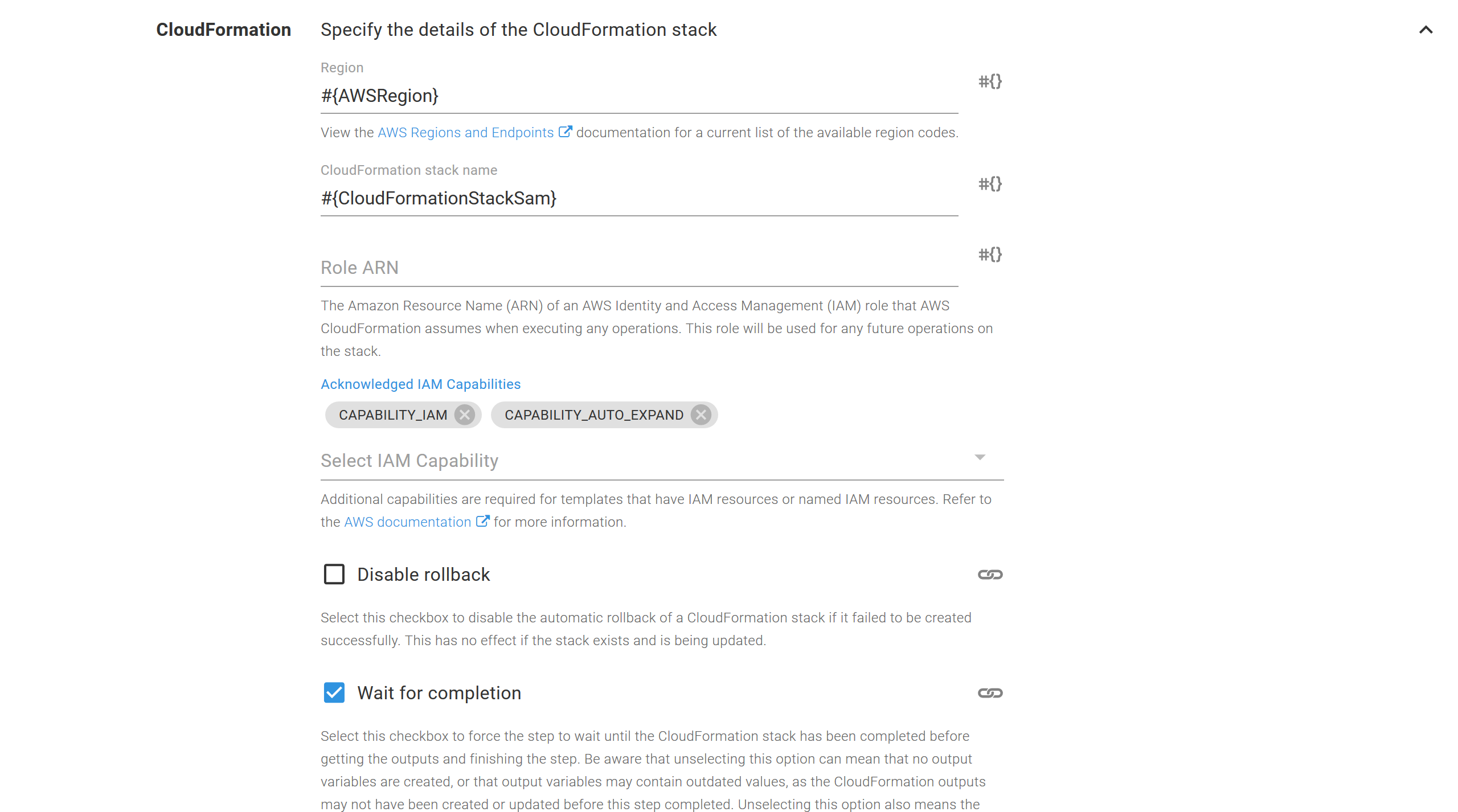
As before, the CloudFormation template will be deployed from a file. Again, we use the AwsSamLambdaTemplates package, but this time, we deploy the template.yaml file.

Octopus variables
Throughout the templates and steps we have used variables to define the AWS region, the S3 bucket names, and the CloudFormation stack names:

The variables are described in the table below.
| Name | Description |
|---|---|
| AWSRegion | The AWS region. |
| CloudFormationStackS3Bucket | The name of the CloudFormation stack that is used to create the S3 Bucket. |
| CloudFormationStackSam | The name of the CloudFormation stack that will deploy the SAM application. |
| S3BucketName | The name of the S3 bucket where the application will be uploaded. |
Deploying to a single environment
Now we have everything we need to deploy our SAM application to a single environment (called UAT) using Octopus.
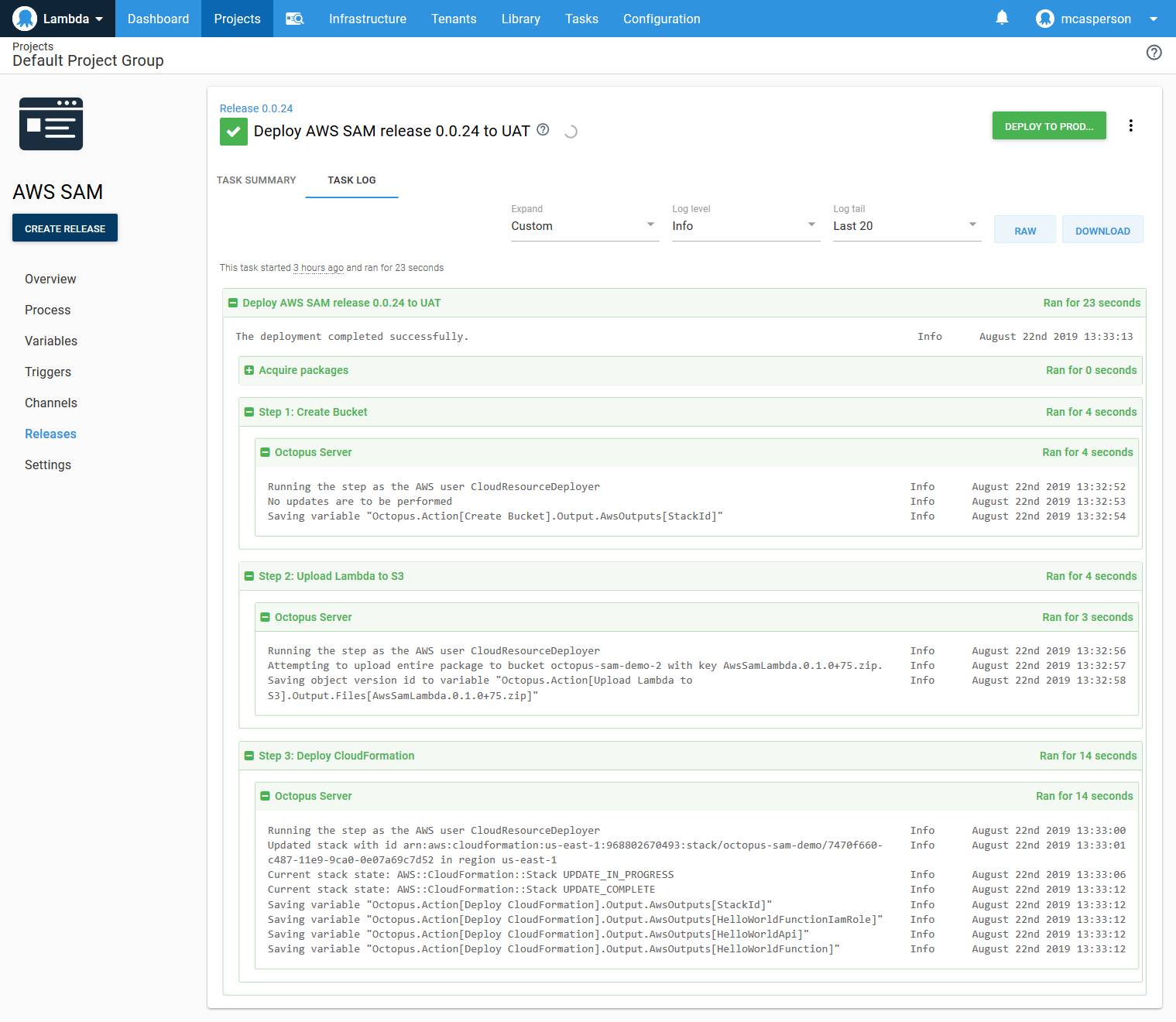
We have successfully created a deployment process in Octopus that replicates the functionality of the SAM CLI tools.
Having the ability to perform repeatable deployments to a single environment is great, but the real power of Octopus is scaling up to multiple environments.
Deploying to a second environment
Because we’ve moved all the environment-specific configuration into Octopus variables, updating our project to deploy to a second environment is as simple as scoping variable values to the new environments.
In this case we add new values for the CloudFormationStackS3Bucket, CloudFormationStackSam, and S3BucketName variables scoped to the next environment called Prod.
This means the new Prod environment will create its own specific CloudFormation stack to create a new S3 bucket and create a second environment-specific CloudFormation stack for the SAM application:
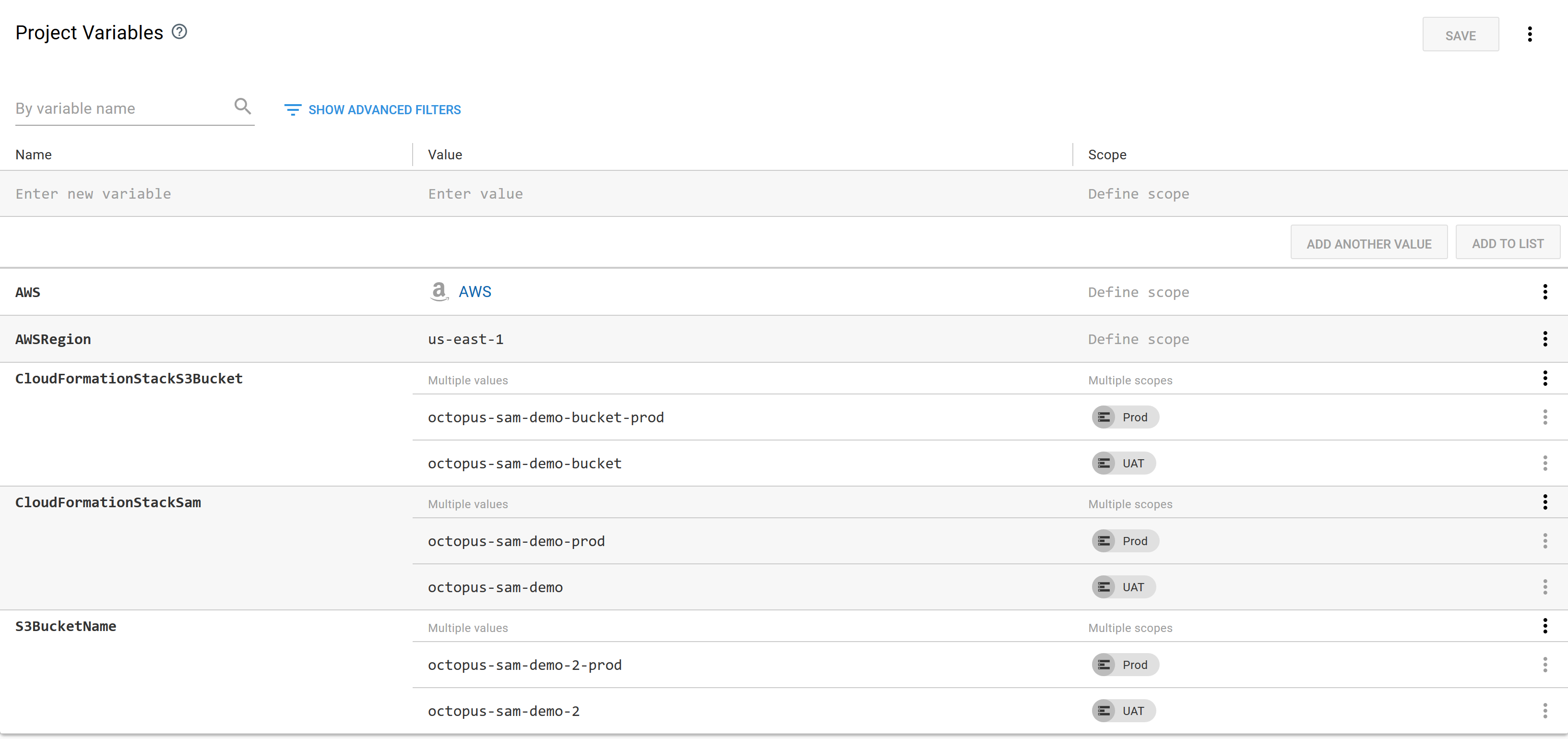
And with those few changes, we have the ability to deploy independent copies of our application into two different environments:
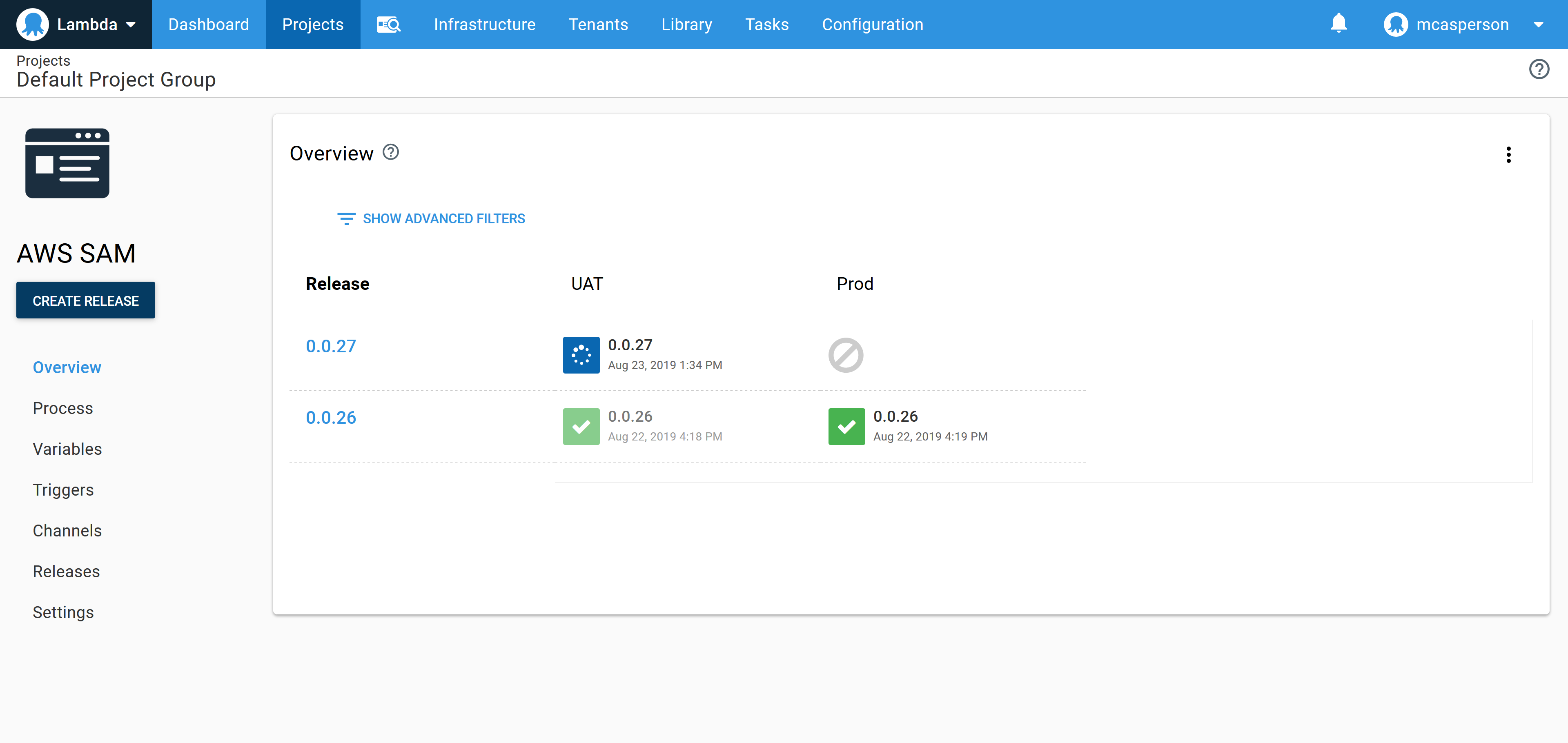
Conclusion
The SAM CLI tools are a convenient way to get a serverless application stack bootstrapped and deployed. By streamlining the common tasks involved in deploying serverless apps, you can deploy a “hello world” application with the commands:
sam init --runtime python3.7sam buildsam package --output-template packaged.yaml --s3-bucket bucket-namesam deploy --template-file packaged.yaml --region region --capabilities CAPABILITY_IAM --stack-name aws-sam-getting-started
In this blog post, we’ve seen how to take the code and templates generated by sam init and sam build, and replace the sam package and sam deploy commands with GitHub Actions and Octopus Deploy.
The end result is a CI/CD pipeline that creates versioned, repeatable deployments across multiple environments. This pipeline can then be easily scaled up to meet the demands of a production environment.
